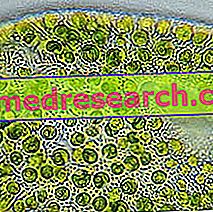Mitomycins are a family of natural aziridines produced by the bacterium Streptomyces caespitosus. This family includes mitomycin A, mitomycin B and mitomycin C (more simply, known as mitomycin).

Mitomycin - Chemical Structure
Mitomycin C is a cytotoxic antibiotic (toxic to cells) and is therefore used in antineoplastic chemotherapy for the treatment of various cancers.
In addition to being cytotoxic, mitomycin C has activity against Gram + and Gram - bacteria, against Rickettsia and against some types of viruses.
Indications
For what it uses
Mitomycin can be used alone or in combination with other anticancer drugs to treat:
- Stomach cancer;
- Esophagus cancer;
- Pancreatic cancer;
- Cancer of the uterus;
- Breast cancer;
- Pulmonary adenocarcinoma;
- Peritoneal carcinosis;
- Bladder cancer;
- Colorectal cancer;
- Skin cancer.
Warnings
Mitomycin should be administered under the strict supervision of a doctor who specializes in the administration of anticancer agents.
Due to the toxicity of mitomycin to bone marrow, blood counts should be carefully monitored in patients taking the drug, including platelets.
Much attention must be paid to the administration of mitomycin in patients suffering from pre-existing myelosuppression (bone marrow suppression), since taking the drug could cause an exacerbation of the myelosuppression itself.
Administration of mitomycin in patients with pre-existing infections could cause them to become worse.
Mitomycin intake by chickenpox patients should be avoided, as drug administration could cause fatal systemic disorders.
The use of mitomycin for long periods can increase its adverse effects.
Caution should be used in the administration of mitomycin in patients with previous liver disease and / or nephropathy.
Mitomycin should be administered with caution in children, taking care to keep them under strict medical supervision so as to identify any side effects.
If extravasation occurs during intravenous injection of mitomycin, infiltration of a solution of sodium bicarbonate and dexamethasone injection is recommended. Furthermore, the parenteral administration of vitamin B6 could be useful, in order to favor the regeneration of damaged tissues.
Those who practice mitomycin injection should be careful not to get the drug into contact with their skin.
Interactions
The bone marrow toxicity of mitomycin can be increased by drugs such as:
- Other anticancer drugs;
- Chloramphenicol (an antibiotic);
- Phenylbutazone (a non-steroidal anti-inflammatory drug) and other types of pyrazolonic anti-inflammatory drugs;
- Phenytoin (an anti-epileptic drug).
Concomitant administration of mitomycin and doxorubicin (an anticancer medicine) may increase doxorubicin-induced cardiotoxicity.
Hepatic inactivation of mitomycin is enhanced by vitamins C, B6 and B2, by inosine and sodium hyposulphite .
Concomitant administration of mitomycin and vinca alkaloids (other anticancer drugs such as - for example - vincristine and vindesine ) can cause dyspnea and bronchospasm. However, the mechanism by which this occurs is not known.
Side effects
Mitomycin can induce a series of side effects whose manifestation can vary greatly from one patient to another. In fact, each individual responds differently to chemotherapy based on their sensitivity to the drug.
Below are the main side effects that may occur following treatment with mitomycin.
Myelosuppression
Treatment with mitomycin can cause myelosuppression. This suppression implies a reduction in blood cell production (reduced hematopoiesis) which can lead to:
- Anemia (decrease in hemoglobin blood levels), the main symptom of the onset of anemia is the feeling of physical exhaustion ;
- Leukopenia (decreased white blood cell levels), with increased susceptibility to contraction of infections ;
- Plateletopenia (decrease in the number of platelets), this leads to the appearance of bruising and abnormal bleeding with an increased risk of bleeding .
Myelosuppression is the main use-limiting side effect of mitomycin. It is a slow effect in manifesting itself, but it lasts for a long time.
Carcinogenicity
Following treatment with mitomycin, cases of acute leukemias and myelodysplastic syndrome (pathology involving hematopoietic stem cells, ie the progenitor cells that generate blood cells) have been reported.
Respiratory disorders
Mitomycin therapy can cause cough, bronchospasm, pneumonia, pulmonary fibrosis and interstitial lung disease . In some cases, pulmonary toxicity can be fatal.
Gastrointestinal disorders
Mitomycin can cause nausea, vomiting and diarrhea .
Vomiting can be controlled by the use of anti-emetic (antivomit) drugs, while diarrhea can be treated with antidiarrheal drugs. If the symptoms occur in a severe form - or if they persist despite the use of drugs - it is necessary to inform the doctor that he could also evaluate the discontinuation of mitomycin treatment. In any case, it is good to drink a lot to replenish lost fluids.
Mitomycin can also cause stomatitis, constipation and abdominal discomfort .
Renal and urinary disorders
Following treatment with mitomycin, renal and urinary disorders may arise, such as:
- Acute renal failure;
- Cystitis;
- Hematuria (presence of blood - visible or not - inside the urine);
- Proteinuria (presence of proteins in the urine);
- Hemolytic uremic syndrome, or a syndrome characterized by the association of pathologies affecting blood and kidneys, such as haemolytic anemia, thrombocytopenia and irreversible renal failure.
Skin and subcutaneous tissue disorders
Mitomycin can cause rashes accompanied by itching, erythema and skin rash . We recommend the use of neutral detergents and - if the doctor deems it necessary - the use of antihistamine creams.
You can also notice changes in the nails that can darken or furrow, but they will return to normal after some time from the end of the therapy.
Furthermore, intraarterial administration of mitomycin can cause damage to the skin such as ulcers, pain, redness, hardening, edema, blisters and erosion of the affected area which can cause skin and muscle necrosis .
Allergic reactions
Mitomycin therapy may cause allergic reactions in sensitive individuals. The symptoms that can occur are dyspnea, sweating, low blood pressure, anaphylactoid reaction and anaphylactic shock.
Hepatobiliary disorders
Treatment with mitomycin can cause liver dysfunction, cholecystitis (inflammation of the gallbladder) and jaundice .
Furthermore - if mitomycin is administered in the hepatic artery - bilomas (bile collection outside the bile ducts), cholangitis (inflammation of the bile ducts) and bile duct necrosis may occur.
Diseases related to the injection site
When mitomycin is administered intravenously, the infusion should take place as slowly as possible in order to avoid the onset of vascular pain and / or thrombophlebitis . Furthermore, if extravasation occurs during administration, it is possible to see the hardening and / or necrosis of the tissues surrounding the injection site.
Intravesical administration of mitomycin may cause bladder contraction; this contraction can cause dysuria (difficulty in excretion of the urine), polyuria (excessive formation and excretion of the urine), perforation of the bladder, necrosis of the bladder and necrosis of the penis .
Other side effects
Other side effects that may occur following the use of mitomycin are:
- Thrombosis;
- Hot flashes;
- Hypertension;
- Temperature;
- Cooling symptoms;
- General malaise;
- Edema.
Overdose
There is no antidote for mitomycin overdose. In case you suspect you have taken an overdose of medication, you must contact your doctor immediately.
Action mechanism
Mitomycin is able to intercalate in the double strand of DNA and - once inside it - is able to form cytotoxic free radicals (toxic to the cells) that cause the breaking and fragmentation of the DNA itself. At this point, the cancer cell is totally deprived of its genetic heritage and - unable to perform any activity - dies.
Furthermore, it appears that mitomycin is also capable of interfering with RNA activity and protein synthesis.
Mode of Use - Posology
Mitomycin is available for intravenous, intra-arterial and intravesical administration. It looks like a powder that must be dissolved in a special solvent just before its use. Once dissolved, mitomycin appears as a purple solution.
Intravenous administration can take place through three different routes:
- Through a cannula (a thin tube) that is inserted into a vein of an arm or hand;
- Through a central venous catheter that is inserted subcutaneously into a vein near the clavicle;
- Through the PICC line ( Peripherally Inserted Central Catheter ), in this case, the catheter is inserted into a peripheral vein, usually of an arm. This technique is used for the administration of anticancer drugs for a prolonged time.
The dosage of mitomycin must be established by the doctor based on the type of tumor that must be treated, based on the type of administration chosen and on the basis of the clinical picture and the patient's condition. Furthermore, the amount of drug administered may vary depending on whether the drug is used alone or in combination therapy.
Intravenous administration
The usual dose of mitomycin administered intravenously is 4-15 mg / m2 of body weight, to be administered at 1-6 week intervals.
Intravesical administration
The dose usually used in this type of administration is 10-40 mg of mitomycin once or twice a week, or at 2-4 week intervals.
Intrarterial administration
The usual dose of mitomycin that is used for intra-arterial infusion is 2-4 mg of drug per day, or 10-30 mg given as a single bolus.
The dose of mitomycin administered is generally reduced when the drug is administered in combination with other anticancer agents.
Pregnancy and breastfeeding
Mitomycin should not be given to pregnant women and breastfeeding mothers.
Contraindications
The use of mitomycin is contraindicated in the following cases:
- Known hypersensitivity to mitomycin and / or to other substances having a chemical structure similar to that of mitomycin;
- In patients with pre-existing myelosuppression;
- In the presence of coagulation disorders;
- In patients at risk of bleeding;
- In patients with severe ongoing infections;
- Pregnant;
- During breastfeeding.



